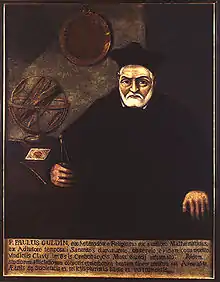Paul Guldin
Paul Guldin (original name Habakkuk Guldin; 12 June 1577 (Mels) – 3 November 1643 (Graz)) was a Swiss Jesuit mathematician and astronomer. He discovered the Guldinus theorem to determine the surface and the volume of a solid of revolution. (This theorem is also known as the Pappus–Guldinus theorem and Pappus's centroid theorem, attributed to Pappus of Alexandria.) Guldin was noted for his association with the German mathematician and astronomer Johannes Kepler.[1] Guldin composed a critique of Cavalieri's method of Indivisibles.[2]
Paul Guldin | |
|---|---|
 Paul Guldin | |
| Born | 12 June 1577 |
| Died | 3 November 1643 (aged 66) |
| Nationality | Swiss |
| Other names | Habakkuk Guldin |
| Occupation | Jesuit mathematician astronomer |
| Known for | Guldinus theorem |
Although of Jewish descent, his parents were Protestants and they brought Guldin up in that faith.[3] He was a professor of mathematics in Graz and Vienna.
In Paolo Casati's astronomical work Terra machinis mota (1658), Casati imagines a dialogue among Guldin, Galileo, and Marin Mersenne on various intellectual problems of cosmology, geography, astronomy and geodesy.
See also
- List of Roman Catholic scientist-clerics
Notes
- Schuppener, Georg (1 December 1997). "Kepler's relation to the Jesuits—A study of his correspondence with Paul Guldin". NTM Zeitschrift für Geschichte der Wissenschaften, Technik und Medizin. 5 (1): 236–244. doi:10.1007/BF02913670. PMID 27742956. S2CID 32688599.
- Amir Alexander (2014). Infinitesimal: How a Dangerous Mathematical Theory Shaped the Modern World. Scientific American / Farrar, Straus and Giroux. ISBN 978-0374176815.
- O'Connor, John J.; Robertson, Edmund F., "Paul Guldin", MacTutor History of Mathematics archive, University of St Andrews.